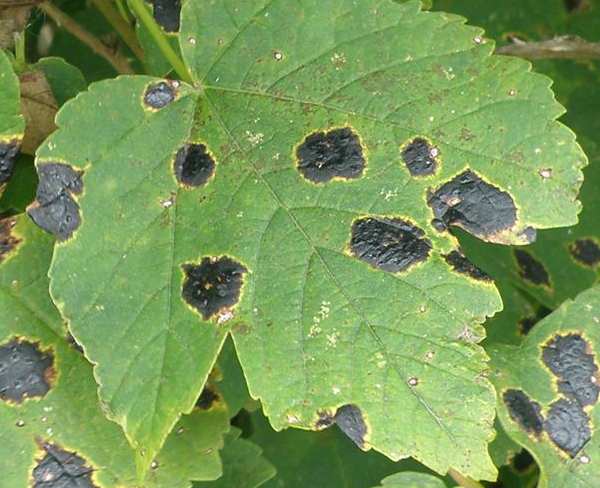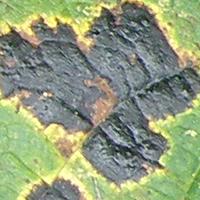Rhytisma acerinum (Pers.) Fr. - Sycamore Tarspot
Phylum: Ascomycota - Class: Leotiomycetes - Order: Rhytismatales - Family: Rhytismataceae
Distribution - Taxonomic History - Etymology - Identification - Reference Sources

Tarspot fungi appear on the leaves of various kinds of trees, including eucalypts and willows, but the one that we see most often - in fact it's almost impossible to find leaves without this fungal infection from midsummer onwards - is Rhytisma acerinum, the Sycamore Tarspot.
Although the presence of these black areas must reduce the photosynthetic capacity of a tree, there is little visible evidence that the tree's health and vigour are significantly affected by tarspot fungi.
Distribution
Rhytisma acerinum, the Sycamore Tarspot, is one of the most common and widespread of ascomycete fungi seen in Britain and Ireland. It occurs across northern and central mainland Europe as well as in North America, wherever Sycamores and their relatives grow and the air is fairly clean - this fungus is particularly sensitive to sulphur dioxide air pollution. Trees growing near to industrial centres with high levels of sulphur emissions do not show any sign of these leaf-blackening fungi.
Taxonomic history
First described scientifically in 1778 by Christiaan Hendrik Persoon, who gave it the binomial scientific name Xyloma acerinum, this species was renamed Rhystima acerinum by the great Swedish mycologist Elias Magnus Fries in 1823.
Synonyms of Rhytisma acerinum include Xyloma acerinum Pers., Melasmia acerina Lév., and Rhytisma pseudoplatani Müll. Berol.
Etymology
The specific epithet acerinum means 'of Acers' - a reference to the fact that this fungus attacks members of the plant family Aceraceae.
Identification guide
 |
FruitbodySterile fungal tissue forms within a leaf of Acer species, notably Sycamore but also Field Maple and the many other tree species from the same genus) and the fungus eventually bursts through the surface as brown spots that expand and soon turn black. These are the 'stroma' in which several apothecia are embedded. Each apothecium, containing the immature asci within which the spores will develop, is covered by a layer of tissue that must eventually open to allow spores to escape. These covered apothecial structures are called the hysterothecia Only after a winter on the ground do the spores within these asci mature, and by that time there are plenty of young sycamore leaves ready to receive them; thus the succession of this ubiquitous fungus is assured. |
Habitat & Ecological role |
Apparently almost harmless or weakly parasitic on living leaves and later saprobic on the fallen leaves of Sycamores and their relatives. |
Season |
Visible on leaves upon trees from early summer until autumn, and thereafter of fallen leaves that gradually rot away... but not until some of the fungi have matured and their spores have been forcibly ejected from the asci. (If some of these mycological terms are new to you, please see our online Glossary...) |
Similar species |
Other tarspot fungi are very similar in structure, although not all produce large stroma with multiple perithecia; some produce tiny dark spots each containing just a single perithecium - Rhytisma punctatum is one such example - and a few cause serious damage to their host trees, particularly thos than infect conifers. |
Reference Sources
Dennis, R.W.G. (1981). British Ascomycetes; Lubrecht & Cramer; ISBN: 3768205525.
Breitenbach, J. & Kränzlin, F. (1984). Fungi of Switzerland. Volume 1: Ascomycetes. Verlag Mykologia: Luzern, Switzerland.
Medardi, G. (2006). Ascomiceti d'Italia. Centro Studi Micologici: Trento.
Pat O'Reilly (2016). Fascinated by Fungi, First Nature Publishing
Paul M. Kirk, Paul F. Cannon, David W. Minter and J. A. Stalpers. (2008). Dictionary of the Fungi; CABI.
Taxonomic history and synonym information on these pages is drawn from many sources but in particular from the British Mycological Society's GB Checklist of Fungi.
Fascinated by Fungi. Back by popular demand, Pat O'Reilly's best-selling 450-page hardback book is available now. The latest second edition was republished with a sparkling new cover design in September 2022 by Coch-y-Bonddu Books. Full details and copies are available from the publisher's online bookshop...

